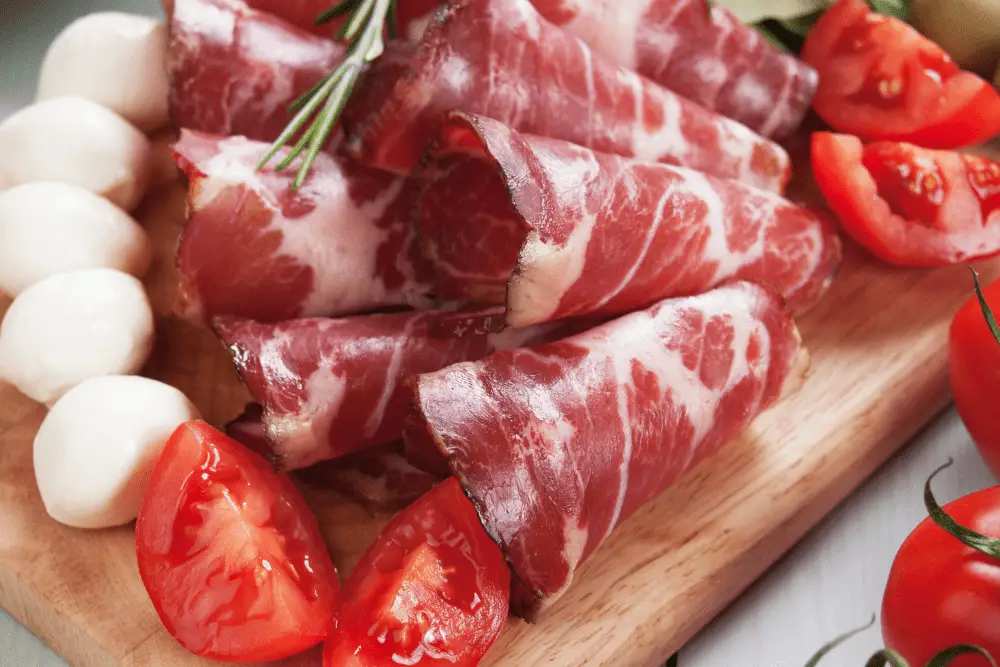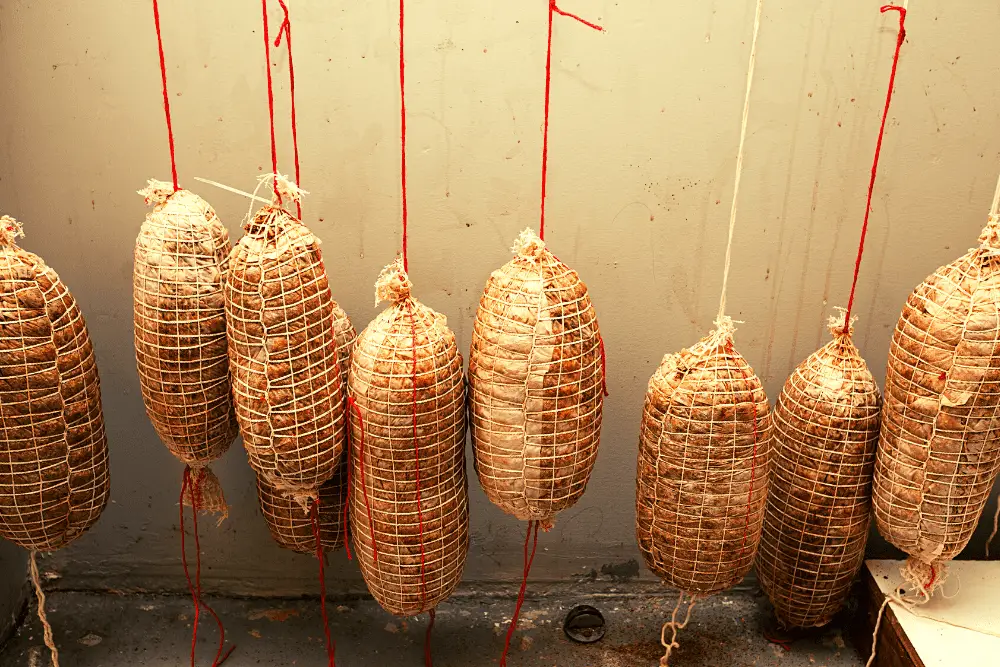Capicola, also called Coppa, Cotto or Gabagool, is made from a prized cut of the neck and shoulder of a pig.It has a mild, slightly sweet flavor and is often served sliced thin on sandwiches or salads.
If you’re looking for a new flavor to add to your next charcuterie board, then look no further than capicola!
Let’s learn more about this delicious meat.
Introduction: What is Capicola?
If you’re a fan of cured meats, then you’ve likely had your fair share of salami, pepperoni, and other such delicacies. But there’s one cured meat that often gets overlooked: capicola.
So what is capicola?
Capicola (or “capocollo”) is a cured meat that hails from Italy. It’s made from the neck or shoulder of a pig or cow, and is typically seasoned with salt, black pepper, and red wine. The result is a delicious, slightly spicy meat that pairs perfectly with a glass of red wine.
What Does Capicola Taste Like?
Unlike ham, the fat in pork neck makes capocollo a soft, tender, and incredibly tasty cut.
When it comes to the taste of capicola, there is a general consensus that it is delicious!
This popular Italian meat product is made from pork shoulder or neck that is slowly cured and then dry-aged. The result is a flavorful, slightly sweet, and very tender meat that can be enjoyed on its own or as part of a sandwich.
While the taste of capicola may be subjective, there are certain flavors that are universally agreed upon. These include a slight sweetness, a hint of spice, and a rich, savory flavor that comes from the slow curing process.
Capicola also has a unique texture that is both tender and slightly chewy, making it an ideal ingredient for sandwiches and other dishes.
If you have never tried capicola before, you owe it to yourself to give this delicious meat product a try.
Salsiccia – Learn about this Italian Sausage

History of Capicola
The first recorded mention of capicola dates back to the 15th century in Italy. At that time, it was a salted and cured pork product that was used as a flavoring for other dishes.
In the 18th century, capicola began to be made with beef as well as pork, and it became a popular ingredient in many Italian dishes.
In the 19th century, capicola made its way to America, where it quickly became a favorite ingredient in many dishes. Today, capicola is still a popular ingredient in many Italian and American dishes. It is also a popular snack food, and can be found in many delis across the country.
How is Capicola made?
The process starts with the neck of a pig. The meat is trimmed and rubbed with a mixture of salt, pepper, and other spices, then cured for several months.
After curing, capicola is typically sliced thin and served as an antipasto or in sandwiches. It can also be cooked and used in recipes like pasta dishes or pizza toppings.
If you’re curious about how this delicious meat product is made, read on to learn more about the process of making capicola.

Types of Capicola
There are many types of capicola, a cured meat made from pork. The most common type is called coppa, which is made from the pork shoulder or neck. Other types include pancetta, guanciale, and lonza.
Coppa is the most flavorful type of capicola and is often aged for several months. It has a firm texture and a slightly fatty taste.
Pancetta is another type of capicola that is also made from pork belly. It has a sweeter flavor than coppa and is often used in dishes like carbonara.
Guanciale is made from pork jowls and has a more intense flavor than other types of capicola. It is often used in recipes that call for pancetta or bacon. Lonza is a leaner type of cured meat that is made from pork loin.
Capicola in popular culture
Capicola has been mentioned in a variety of tv shows and movies and has entered popular culture in that way.
The show Seinfeld also had an episode where the character Elaine was trying to get a job at a company that made capicola.
The movie Goodfellas also mentions capicola in a scene where the characters are discussing what type of food they should get for their boss.
In the television series The Sopranos, capicola was mentioned several times as a type of food that the characters enjoyed.
Here is a montage of a few of these scenes.
Bresaola: the air-dried, salted beef that’s perfect for a summer dish
Video: How Capocollo (Gabagool) Is Made In Italy
You may know it by the name of capocollo, coppa, capicola, gabagool — dozens of names to describe one Italian delicacy: a distinctive cured meat made from pork neck, easy to spot thanks to its vivid red color and beautiful marbling.
Unlike ham, the fat in pork neck makes capocollo a soft, tender, and incredibly tasty cut. Capocollo from Martina Franca is a blend between two unique things: the very Italian practice of curing pork neck, and where it is made — the Itria Valley, a hilly farmland with fertile soils. This video is a visit to Salumi Cervellera, a family-run business in the heart of the Itria Valley, to find out more about how its traditional capocollo is made.
Italian Speck – Everything you need to know!
Capicola Summary
In conclusion, capicola is a delicious, versatile and spicy cured pork that can be enjoyed in many different ways.
Whether you’re enjoying it as a sandwich meat, using it to top a pizza, or eating it on its own as a snack, there’s no doubt that capicola is a tasty treat. And because of the spice, it also pairs well with a full bodied red wine.
So next time you’re looking for something new to try at your local Italian deli, be sure to give this delicious meat a try.

Capicola Frequently Asked Questions (FAQs)
What are the ingredients in capicola?
Capicola, also known as coppa, is a cured Italian meat that is made from the neck or shoulder of a pig. The meats are dry-cured with a mixture of salt, sugar, and spices, and then aged for several months.
The most common spices used in the curing process are black pepper, cloves, fennel seeds, and chili flakes.
Some recipes use other spices and aromatics like bay leaves, rosemary, or thyme.
It is the blend of the aromatics and spices use that affect the flavor as the curing process leads to evaporation of water and accentuates the spices and aromatics.
How does capicola compare to salami?
A cured meat liked capicola falls under the salumi umbrella. Salumi refers to the process of curing and preserving meats (source). Salumi is not the same as salami though – Salami refers to a specific type of sausage. Even though the meats are in the same family, they have different production methods, different ingredients and taste quite different. In short, they have different flavor profiles.
Is Capicola the same as ham?
No, it is not. Capicola is a type of ham that is made from pork shoulder. It is not brined as ham typically is. So technically it is considered ham but it tastes quite different from regular ham.
My name is Jay and I started this website to share my love of Deli Food. I am Jewish with Italian ancestry and grandparents who emigrated to the US from Poland, Russia and Turkey. This website is my celebration of the delicious flavors of international deli culture. Please feel free to send me your suggestions and feedback through the contact form.

